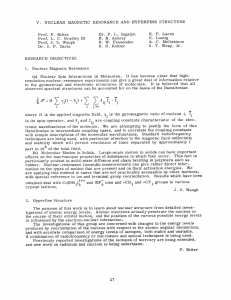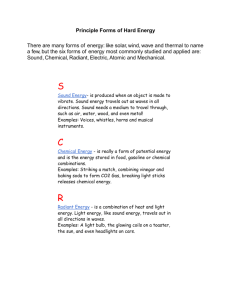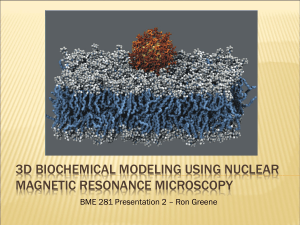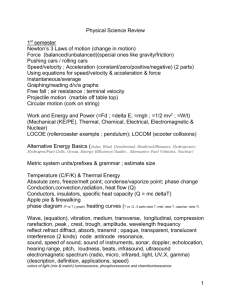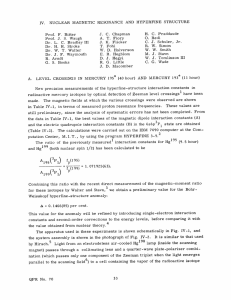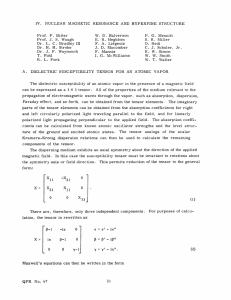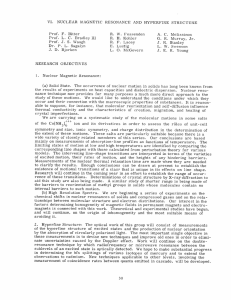VII. NUCLEAR MAGNETIC RESONANCE AND HYPERFINE ... H. C. Praddaude E. R. Hegblom
advertisement
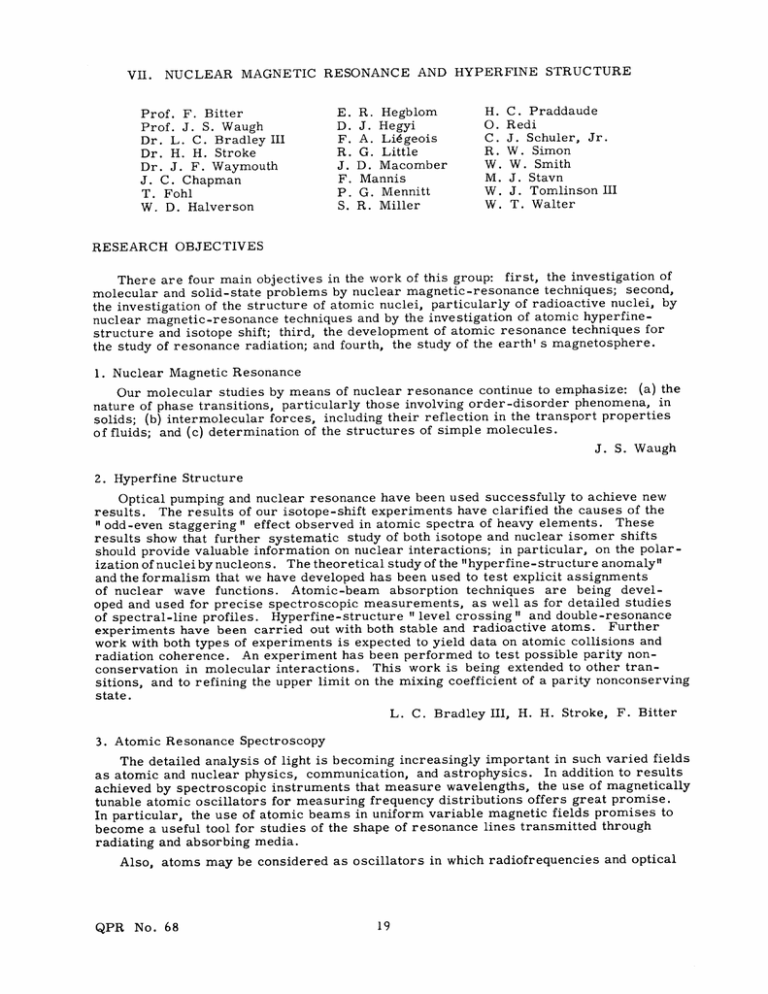
VII. NUCLEAR MAGNETIC RESONANCE AND HYPERFINE STRUCTURE Prof. F. Bitter Prof. J. S. Waugh Dr. L. C. Bradley III Dr. H. H. Stroke Dr. J. F. Waymouth J. C. Chapman T. Fohl W. D. Halverson E. D. F. R. J. F. P. S. R. Hegblom J. Hegyi A. Li6geois G. Little D. Macomber Mannis G. Mennitt R. Miller H. O. C. R. W. M. W. W. C. Praddaude Redi J. Schuler, Jr. W. Simon W. Smith J. Stavn J. Tomlinson III T. Walter RESEARCH OBJECTIVES There are four main objectives in the work of this group: first, the investigation of molecular and solid-state problems by nuclear magnetic-resonance techniques; second, the investigation of the structure of atomic nuclei, particularly of radioactive nuclei, by nuclear magnetic-resonance techniques and by the investigation of atomic hyperfinestructure and isotope shift; third, the development of atomic resonance techniques for the study of resonance radiation; and fourth, the study of the earth' s magnetosphere. 1. Nuclear Magnetic Resonance Our molecular studies by means of nuclear resonance continue to emphasize: (a) the nature of phase transitions, particularly those involving order-disorder phenomena, in solids; (b) intermolecular forces, including their reflection in the transport properties of fluids; and (c) determination of the structures of simple molecules. J. S. Waugh 2. Hyperfine Structure Optical pumping and nuclear resonance have been used successfully to achieve new results. The results of our isotope-shift experiments have clarified the causes of the " odd-even staggering " effect observed in atomic spectra of heavy elements. These results show that further systematic study of both isotope and nuclear isomer shifts should provide valuable information on nuclear interactions; in particular, on the polarization of nuclei by nucleons. The theoretical study of the "hyperfine- structure anomaly" and the formalism that we have developed has been used to test explicit assignments of nuclear wave functions. Atomic-beam absorption techniques are being developed and used for precise spectroscopic measurements, as well as for detailed studies of spectral-line profiles. Hyperfine-structure " level crossing" and double-resonance experiments have been carried out with both stable and radioactive atoms. Further work with both types of experiments is expected to yield data on atomic collisions and radiation coherence. An experiment has been performed to test possible parity nonconservation in molecular interactions. This work is being extended to other transitions, and to refining the upper limit on the mixing coefficient of a parity nonconserving state. L. C. Bradley III, H. H. Stroke, F. Bitter 3. Atomic Resonance Spectroscopy The detailed analysis of light is becoming increasingly important in such varied fields as atomic and nuclear physics, communication, and astrophysics. In addition to results achieved by spectroscopic instruments that measure wavelengths, the use of magnetically tunable atomic oscillators for measuring frequency distributions offers great promise. In particular, the use of atomic beams in uniform variable magnetic fields promises to become a useful tool for studies of the shape of resonance lines transmitted through radiating and absorbing media. Also, atoms may be considered as oscillators in which radiofrequencies and optical QPR No. 68 (VII. NUCLEAR MAGNETIC RESONANCE) frequencies are coupled whenever the simultaneous absorption of two such different frequencies involves a common level. Subtle line-narrowing effects resulting from the imprisonment of optical resonance radiation have been detected by using doubleresonance techniques. Experimental investigations to determine the relative importance, on the one hand, of interatomic coupling caused by the radiation field, and on the other hand, of the degree of coherence of the light in an absorbing cell should prove to be of value in various investigations. Work in both of these areas was started some time ago in connection with hyperfinestructure investigations and will now be continued for its own sake. H. H. Stroke, L. C. Bradley III, F. Bitter 4. The Earth' s Magnetosphere Data obtained from satellites and space probes on the nature of the interplanetary medium are reviving interest in laboratory experiments related to the conditions found in space. We propose to set up models of the earth and its surrounding magnetic field, and to study, first of all, the diffusion of electrons and properties of trapped charges in the surrounding Van Allen belts. The basic condition to be satisfied is that the ratio of the electron cyclotron radius " a" , a my eB 1 BI /2mV / e have the same ratio to, or should at least be adequately smaller than, the radius of the solid model. If R is the radius of the model, and r the radial distance from the center of the model to any point in space, we have, if the average intensity of magnetization of the spherical dipole is I, the surrounding field in the equatorial plane given by I( . o B 3 47T 7r R 3) r3 and therefore the required ratio a/R is a -= R 8 (r)3 8 IR-V(jR 22 2 6 amp-meter , R = 6.4X10 meters, For the earth, we have a magnetic moment 8. 2X10 and an average intensity of magnetization I = 76 amp/meter. For the outer edge of the Van Allen belt near the surface of the magnetosphere, R) = 10 V = 5x104 electron volts; and consequently a 80. 71X10 2 =8X10 R 8 4.9X10 3 1. = 1.2X10 -3 . Two spherical dipoles have been designed by Bruce Montgomery of the National Magnet Laboratory. The first is a superconducting coil with an iron core having a magnetic moment 820 amp-m2 and a diameter of 2" . The second is a water-cooled solenoid with an iron core having a magnetic moment 14, 000 amp-m2 QPR No. 68 and a diameter of 7", (VII. requiring 500 kw for its operation. NUCLEAR MAGNETIC RESONANCE) The values of a/R for these dipoles at points distant - 2 NV. These would seem to be adequate models for 10 R from their centers is 3-4 X 10 a convenient range of electron energies. The field of these dipoles at a distance 10 R, or 10" and 35" , respectively, would be 20-50 gauss. It would be quite feasible to immerse them in very large coils that produce fields of this order of magnitude to simulate the interplanetary field bounding that of the earth, if it should become desirable for other lines of investigation. A further requirement of such a model would be that the pressure be made low enough so that electronic mean-free paths would be at least of the order of meters. This indicates operation at pressures below 1 micron, or with an atom density below 1013 per cubic centimeter. Insofar as pumping or the production of localized discharges to generate ions and electrons are concerned, this offers no difficulty. The minimum electron densities required for convenient observations by means of Langmuir probes are of the order of 109 per cubic centimeter. This is in a range that would appear to be of interest and practically achievable, at least locally in a large tank. The electronics of the problem is perhaps its most critical aspect. Other approaches for work at very low densities would seem to be desirable. This program marks the evolution of work on mercury-rare gas discharges, which has been going on for the past two years. The theory of Langmuir-probe measurements in a magnetic field has been developed by J. F. Waymouth. 1 Observations have been made by T. Fohl on the diffusion and thermal conductivity of electrons in a large spherical container with a localized discharge at the center. Magnets for the study of cylindrical plasmas in cusped or uniform longitudinal fields, and in quadrupole or uniform transverse fields are available. It is hoped that these investigations will lead to actual magnetosphere model experiments in the course of the coming year. Bitter, H. H. Stroke F. References 1. J. F. Waymouth, Perturbation of a Plasma by a Probe, Technical Report 406, Research Laboratory of Electronics, M. I. T., December 26, 1962. HYPERFINE STRUCTURE AND ISOTOPE SHIFTS IN NEUTRON-DEFICIENT A. MERCURY ISOTOPES Production techniques are now under study for the purposes of obtaining Hg 1 9 3 and Hg193 . free of Hg I(Hg 19 3 and Hg 1 95* to permit a verification of the preliminary assignment, 19 5 ) = 13/2 and 4.(Hg 1 9 3 * ) .(Hgl 9 5*), and to obtain the Hg 19 3 spectrum.1 These results refer solely to the 2537 A resonance line. The spectrum of Hg 194 has been observed over a period of almost one year, in the hope that by comparing its intensity with that of stable Hg 96 , which was produced simultaneously in the bombardment, we may be able to determine its halflife. At present we are investigating the influence of self-absorption and cleanup on such a determination. We have also obtained a corrected value for the Hg194-Hgl96 isotope shift in the 2537 A line (0. 280+ 0. 015) cm-1. nearly equal to unity. The result is that y(195) and y(1 5") are even more 2 W. J. QPR No. 68 9 Tomlinson III, H. H. Stroke (VII. NUCLEAR MAGNETIC RESONANCE) References 1. W. J. Tomlinson III and H. H. Stroke, Hyperfine structure and isotope shifts in Hgl 9 5 , Hgl 9 5 , Hg 9 4 , and Hg 1 9 3 , Quarterly Progress Report No. 66, Research Laboratory of Electronics, M. I. T., July 15, 1962, pp. 18-19. 2. W. J. Tomlinson III and H. H. Stroke, Phys. Rev. Letters 8, 436 (1962). QPR No. 68


